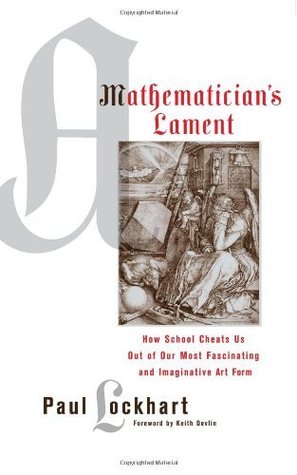More on this book
Community
Kindle Notes & Highlights
Sadly, our present system of mathematics education is precisely this kind of nightmare. In fact, if I had to design a mechanism for the express purpose of destroying a child’s natural curiosity and love of pattern-making, I couldn’t possibly do as good a job as is currently being done—I simply wouldn’t have the imagination to come up with the kind of senseless, soul-crushing ideas that constitute contemporary mathematics education.
It is every bit as mind-blowing as cosmology or physics (mathematicians conceived of black holes long before astronomers actually found any), and allows more freedom of expression than poetry, art, or music (which depend heavily on properties of the physical universe). Mathematics is the purest of the arts, as well as the most misunderstood.
A mathematician, like a painter or poet, is a maker of patterns. If his patterns are more permanent than theirs, it is because they are made with ideas.
There’s no ulterior practical purpose here. I’m just playing. That’s what math is—wondering, playing, amusing yourself with your imagination. For one thing, the question of how much of the box the triangle takes up doesn’t even make any sense for real, physical objects.
This is the amazing thing about making imaginary patterns: they talk back! The triangle takes up a certain amount of its box, and I don’t have any control over what that amount is.
But it’s not the fact that triangles take up half their box that matters. What matters is the beautiful idea of chopping it with the line, and how that might inspire other beautiful ideas and lead to creative breakthroughs in other problems—something a mere statement of fact can never give you. By removing the creative process and leaving only the results of that process, you virtually guarantee that no one will have any real engagement with the subject.
Mathematics is the art of explanation. If you deny students the opportunity to engage in this activity—to pose their own problems, to make their own conjectures and discoveries, to be wrong, to be creatively frustrated, to have an inspiration, and to cobble together their own explanations and proofs—you deny them mathematics itself.
Everyone knows that poetry and music are for pure enjoyment and for uplifting and ennobling the human spirit (hence their virtual elimination from the public school curriculum), but no, math is important.
The saddest part of all this “reform” are the attempts to “make math interesting” and “relevant to kids’ lives.” You don’t need to make math interesting—it’s already more interesting than we can handle! And the glory of it is its complete irrelevance to our lives. That’s why it’s so fun!
You think something practical like compound interest is going to get them excited? People enjoy fantasy, and that is just what mathematics can provide—a relief from daily life, an anodyne to the practical workaday world.
Give your students a good problem, let them struggle and get frustrated. See what they come up with. Wait until they are dying for an idea, then give them some technique. But not too much.
If teaching is reduced to mere data transmission, if there is no sharing of excitement and wonder, if teachers themselves are passive recipients of information and not creators of new ideas, what hope is there for their students? If adding fractions is to the teacher an arbitrary set of rules, and not the outcome of a creative process and the result of aesthetic choices and desires, then of course it will feel that way to the poor students.
Teaching is not about information. It’s about having an honest intellectual relationship with your students. It requires no method, no tools, and no training. Just the ability to be real. And if you can’t be real, then you have no right to inflict yourself upon innocent children.
Could anything be more unattractive and inelegant? Could any argument be more obfuscatory and unreadable? This isn’t mathematics! A proof should be an epiphany from the gods, not a coded message from the Pentagon. This is what comes from a misplaced sense of logical rigor: ugliness.
To me the important step is not the move from rocks to symbols, it’s the transition from quantity to entity—the conception of five and seven not as amounts of something but as beings, like hamsters, which have features and behavior.
I am drawn in by the possibility of a connection—a new, unforeseen relationship that will improve my intuition and perhaps permanently change the way I think about these objects. I suppose that’s really a key part of it for me: I want to be changed. I want to be affected in a fundamental way. That’s maybe the biggest reason why I do mathematics. Nothing I have ever seen or done comes close to having the transformative power of math.
Proof is our way of capturing an infinite amount of information in a finite way. That’s really what it means for something to have a pattern—if we can capture it with language.
Children understand this. They know that learning and playing are the same thing. How sad that the grownups have forgotten. They think of learning as a chore, so they make it into one. Their problem is intentionality.


